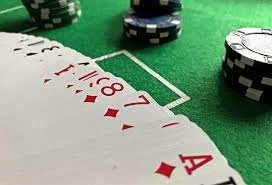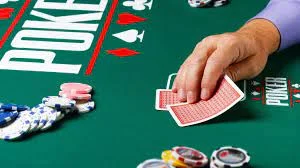7 Card Stud
Seven Card Stud is an example of classic poker, a game where the main goal is not just to participate but to win the entire pot. Among all varieties of poker, it has cemented its status as one of the most revered, attracting players who appreciate its subtle play and rich history. Unlike its more commonly televised counterparts, Texas Hold’em and Omaha, seven-card stud offers a unique feature; there are no common cards. Instead, players deal face-down and face-up cards over the course of several rounds, requiring a combination of memory, strategy, and keen observation.
Unlike Texas Hold’em, where the focus is often on playing with common cards, and Omaha, where players must navigate the complexities of multiple hole cards, Seven Card Stud rewards those who follow the game closely, memorize the folded cards, and calculate the odds accurately. Each player’s partially open hand provides a tantalizing glimpse into possible outcomes, furthering the game.
Next, we dive into the intricacies of seven-card stud, laying out the basic rules and fundamentals of the game in a way that is accessible to beginners. Our goal is to cover this variation by explaining how each round plays out, from the initial deal to the climactic showdown.
How to Play 7 Card Stud
The essence of seven-card stud is rooted in its rich tradition as one of the pillars of the poker world, offering a combination of strategy, memory and skill. Unlike card games such as Texas Hold’em and Omaha, in seven-card stud each player is dealt his or her individual hand, consisting of a mix of face-down (hole cards) and face-up (door cards) cards, over several rounds of betting. This unique structure challenges players to compose the best five-card hand from the seven cards dealt to them, while navigating the intricacies of betting and reading their opponents’ hands.

Number of Streets
The game of seven-card Stud unfolds on five “streets.” After the first hand, when players receive their starting hands, the game goes through additional stages with each betting round. On each street, players receive an additional card, either face up or face down, depending on the round. These stages are very important for strategizing, as players must decide whether to continue based on the strength of their cards and the perceived strength of their opponents’ hands.
Betting and ante
Betting in seven-card stud is determined by the table limits and is usually constructed as fixed-limit bets. Unlike no-limit and pot-limit games, in seven-card stud fixed limits impose restrictions on bets and raises, making strategic bet sizing and timing crucial elements of the game.
Before the cards are dealt, all players must ante into the pot. The ante is a mandatory bet that ensures that there is something to play for at the beginning of each hand, which forces all participants to act and invest immediately. For example, in a $2/$4 Seven Card Stud game, the ante can be set at $0.50. This means that each player must pay $0.50 to participate in the hand, which sets the stage for the initial round of betting and the subsequent hand.
Streets in a Seven-Card Stud
Seven Card Stud differs from other popular poker varieties, such as Texas Hold’em and Omaha, in the large number of betting rounds called “streets”. This unique structure adds complexity to the game, offering players many opportunities to play strategically and adjust depending on the cards revealed at each stage. There are five betting streets in seven-card stud, each of which plays an important role in the development of the hand.
- Third Street: Play begins with players being dealt three cards each – two face down and one face up. The first round of betting begins with the player showing the lowest card face up. This initial phase sets the tone for the hand as players begin to assess the strength of their starting position.
- Fourth Street: Each player is dealt another face-up card. Now that there are two visible cards in play, the player with the best poker hand begins to bet. This street is a crucial point in the game, as players have more information to evaluate their chances and decide on their next move.
- Fifth Street: Each player receives a third card face up, which leads to another round of betting. From this street onwards, the betting size usually increases, reflecting the players’ clearer idea of the strength of their hands. It is at this point that play often becomes more intense, stronger hands appear, and strategic decisions become more important.
- Sixth Street: The last face-up card is dealt and another round of betting follows. By this point, players have a clear idea of the potential of their hand and must carefully consider their position in relation to their opponents. Sixth Street is the key to making the final bets that can affect the outcome of the game.
- Seventh Street (or river): The last card is dealt face down, giving players their final hand. This final round of betting is the last chance for players to affect the pot. Strategy here depends heavily on a player’s ability to bluff or secure the pot with a strong hand in the ensuing showdown.
7 Card Stud Hands
Like any other poker game, seven-card stud revolves around the concept of betting, with the ultimate goal being to secure the pot by having the best hand or convincing opponents to fold. The strength of a player’s hand, from the strongest to the weakest, plays a key role in determining the strategy of betting, call, raise or fold. Below are rankings of hands in seven-card stud, listed from strongest to weakest, along with examples to help beginners understand the possible combinations:

- Royal Flush: The top of a poker hand consisting of A, K, Q, Q, J, 10 of the same suit. Example: A♠ K♠ Q♠ J♠ 10♠.
- Straight Flush: Five consecutive cards of the same suit. Example: 9♦ 8♦ 7♦ 6♦ 5♦.
- Four of a Kind: Four cards of the same rank. Example: 6♣ 6♠ 6♦ 6♥ 9♠.
- Full House: Three cards of the same kind combined with a pair. Example: J♥ J♦ J♠ 4♦ 4♠.
- Flush: Five cards of the same suit not in consecutive order. Example: K♣ J♣ 9♣ 6♣ 3♣.
- Street: Five consecutive cards of different suits. Example: 10♠ 9♦ 8♥ 7♣ 6♠.
- Three of a Kind: Three cards of the same rank. Example: 8♠ 8♦ 8♣ K♥ J♦.
- Two Pairs: Two different pairs. Example: Q♣ Q♠ 7♦ 7♣ 4♠.
- Pair: Two cards of the same rank. Example: A♦ A♣ 10♠ 5♦ 2♠.
- Senior Card: If no one has any of the above combinations, the oldest card in the hand. Example: K♥ J♦ 8♣ 5♠ 3♦.
Tips for Playing Seven-Card Stud
In seven-card stud, mastery of different strategies is crucial to improving your gameplay and increasing your chances of success. While no single strategy guarantees victory, a combination of different game-sensitive tactics can greatly improve your results. Here are four strategies that can make all the difference in effectively navigating the challenging stages of seven-card stud.
Pay attention to visible cards
A unique aspect of seven-card stud is the wealth of information available through your opponents’ cards. Keeping an eye on these visible cards is important, as it will allow you to assess the strength of your hand compared to others and make an informed decision to bet, counter or fold. By observing which cards are live or discarded, you will be able to better assess your chances of improving your hand and strategize accordingly.
Choosing a starting hand
The foundation of a strong seven-card stud strategy starts with choosing the right starting hands. Prioritize threes, big pairs, connectors and strong cards as they have more potential to develop strong hands. Avoid playing weak starting hands as they have less chance of 7 card studimprovement and can deplete your chip stack over time. Figuring out which hands to play and which ones to discard early on can save you from making costly mistakes.
Manage your bankroll wisely
Bankroll management is very important in seven-card stud, where betting rounds can quickly increase the size of the pot. Set betting limits and stick to them so you don’t overextend yourself in any hand. Keep an eye on your bankroll, this will help you stay in the game longer and avoid the pressure of playing scared money which can lead to bad decisions.
Bluff infrequently
While bluffing is an integral part of poker, it should be used cautiously in seven-card stud. Given the amount of information available through the flipped cards, successful bluffing becomes more difficult. Use bluffs in situations where your visible cards indicate a strong hand or when you have built up a tight game image. A well-calculated bluff can be effective, but overusing it can make you predictable and easy to read.

